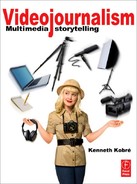CHAPTER 4
Producing a Story
▲ Keeping Track. As they are shooting a story, some videojournalists make notes to remind themselves of shots they need to complete a story arc. ![]()

(Photo by Josh Meltzer)
This symbol indicates when to go to the Video journalism website for either links to more information or to a story cited in the text. Each reference will be listed according to chapter and page number. Links to stories will include their titles and, when available, images corresponding to those in the book. Bookmark the following URL, and you’re all set to go: http://www.kobreguide.com/content/videojournalism.
So you’ve found what you think will be a good video or multimedia story You’ve determined that it at least appears to have some of the necessary components to be a successful story:
• It has a narrative line and potential conflict or tension.
• It has strong characters.
• It contains universal and pertinent themes outside of the story itself.
• It has something to say about the human condition or has direct relevance to significant, meaningful issues.
But wait! Not so fast. Do you have an actual plan or outline for the story you’re going to tell? Have you any idea who you might need to interview? Do you know what direction the story might be going in?
MAKING A PLAN
Multimedia journalist and teacher Bob Sacha likes to have a clear idea of what he’s attempting to accomplish before he heads out to the field. “A certain amount of planning ahead prevents me from shooting wildly,” he says, “and it keeps me from gathering too much irrelevant material.” He says the story doesn’t have to end up following the scenario he initially sets out to cover, but at least his plan gives him a starting point. Moreover, we know that most journalists have limited time to report. So a solid plan is a definite aid to using that time wisely. “I’m always thinking of what the conflict is going to be,” he says. “Entering the fray on a prayer is a universally recognized bad idea”.
Research is one of the most effective tools you have for maximizing your story’s potential. First you need to hatch the idea, then you analyze it and decide whether a story exists. You must be sure the piece will contain sufficient conflict, and finally, you have to develop a hypothesis for what you think might happen.
Many videojournalists create a storyboard to keep track of all the elements in their story. (See also Chapter 13, “Editing.”) Make notes of scenes on sticky notes or index cards. Each note card will represent a scene in your story. The scene sketches don’t have to be sophisticated. They are strictly for use by you. So even scribbles and stick figures will do. Lay the individual sketches out in the order you think they might appear in your final video. You can rearrange the cards as you go along and see how to improve the narrative impact of your story. The notes are there to help you tell your story as clearly as possible. These simple note cards will give you clues about missing actions or transitions. If you realize a scene is missing, create a new card and add the scene to your required shot list. This simple index card method ensures that you don’t repeat yourself or let your story sprawl too far in one direction or another.
By the way, rather than using note cards and hand drawn stick figures, you can use any of a number of software programs designed to help you produce a storyboard. Some videojournalists find these electronic storyboards easier and faster than the traditional paper-and-pencil method.
You can make the storyboard as detailed as you like. You should include opening and closing shots as well as transitions that take your audience smoothly from one scene to another. Quite naturally, as you shoot your story, you will constantly be changing your original storyboard to make it coincide with the actual scenes you have recorded. It’s like a crossword puzzle, except you make the pieces. Depending on what your characters say and do during the shoot, you adjust the order of your pieces. The value of this kind of storyboard is that it allows you to spread out the “big picture” and see, as well as adjust, the shape of your story as reality unfolds.
COMMITMENT STATEMENT
A good story structure depends on, among other things, staying focused on what the story is really about. Viewers, it turns out, can track only one thing at a time. To ensure that the message is getting through to them, maintaining a sharp focus is critical. Longtime TV photojournalist, editor, and teacher Sharon Levy-Freed advises that you create a commitment statement (also called a focus statement). She suggests we try thinking about stories as a one-sentence summary with a subject (character), a verb, and an object.
For instance, “Mary Livingston overcomes spousal abuse through prayer” is an example of a commitment statement. The subject is “Mary.” The verb is “overcomes.” And the object is “spousal abuse.” The videojournalist could record Mary talking about spousal abuse, then document any evidence that her husband harmed her, and finally, show the prayer in Mary’s life that helps her to confront and overcome the abuse.
So before you can build your story, you need to be clear about its focus. Thinking of the story itself as a full sentence containing only a subject, a verb, and an object will show you how to find the story’s structure.
Boil It Down
At the Advanced Storytelling Workshop put on by the National Press Photographers Association, students are instructed to find a story and then write a brief commitment statement. This statement is the heart and soul of the story and will guide them both in the field and during the edit.
Though this book is about short-form stories for the Internet, some television videojournalists also tell stories (not just record the news). Boyd Huppert, of KARE Channel 11 Minneapolis, is one of TV’s short-form storytellers.
As one of the workshop leaders, he took participants through a real-life example of honing a focus statement using one of his own KARE-TV stories, a piece about an elderly woman named Clara who learned one day, after a spring storm, that her lifetime home would be threatened either overnight or the next morning by approaching flood waters. As he drove to the town that was awaiting the approaching flood, Huppert’s focus statement went through five different stages. His focus evolved from “Sent out to cover flood” to “This flood is impacting individuals” to “Clara is packing up” to “Clara packs up to save her past” to the story’s final focus, which was: “Clara struggles as she packs up to save her past”.
“A story’s focus can be in a character, or an emotion, or a concept,” Huppert says. “It’s got to be something that ties the otherwise disconnected pieces of a story together. There are a lot of stories that may not have a strong central character. When that happens, you have to replace the strong character by finding a concept that ties everything together”.
Understanding the central role that focus plays in storytelling is key. Not understanding how to gain and maintain focus can jeopardize the quality of the final product.
Scott Rensberger, a freelance TV journalist who has traveled the globe and is a faculty member at the National Press Photographers Association storytelling workshop, follows such advice and boils his story idea down to a simple phrase. “If I can say what the story is about in one line and everyone wants to see it—you know it’s going to be good. How can you screw up? ‘The world’s largest machine gun shoot;’ A dog who thinks he’s a postal worker;’ or A happy couple that has been married 82 years.’” A simple, powerful sentence will help guide you and keep you on track through every step of the storytelling process. You will also find this simple sentence, or commitment statement, approach to be particularly useful during the editing phase. ![]()
YOUR PRIMARY CHARACTERS
After you’ve boiled the concept for your story down to a single sentence, it’s time to decide who will tell the story. Who are your primary characters?
Who Can Represent the Story Best?
Months before his story “Uprooted” was produced, Dai Sugano, a multimedia videojournalist at the San Jose Mercury News, read an article in his paper about a trailer park’s upcoming closure. The city of Sunnyvale, California, was attempting to close the Flicks Mobile Home Park via eminent domain for a large-scale construction project. “When I read it,” Sugano says of the news story, “I knew that this was only the beginning of what could be a series of unfolding events. I went to the trailer park one day and knocked on several doors searching for residents who would be open to letting me follow them through their journey”.
Knocking on doors is a good way to start, but you can’t stop there. Next, choose and then interview the primary characters in your story. This second step is as important as the narrative itself. The trailer park in question had many residents. Some were American families, some immigrants, and some elderly. Sugano molded his story around two central characters—an immigrant family and an elderly single woman.
◀ Uprooted. Its owners were closing down and selling the Flicks Mobile Home Park. The photographer went from door to door to find subjects. ![]()

(Photo by Dai Sugano)
◀ Luis Trujeque and his daughter Minelia live in the Flick’s Mobile Home Park in Sunnyvale, California, and face having to move if the park is closed.
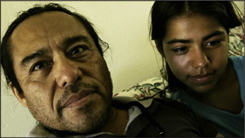
▶ After 26 years of living at the mobile home park, Marilyn Baker will have to move if it closes.

▼ Marilyn Baker pauses while packing up to leave.

▶ Marilyn Baker addresses Sunnyvale city leaders about plans to close the mobile home park where she has lived for 26 years. Sugano was looking for two things in his story’s characters: that they would be open, have a compelling story and could represent the residents of the community he was covering.

(Photos by Dai Sugano, San Jose Mercury News)
“When working in multimedia, it is not only important to find subjects who will allow you the access you need to tell the story visually but you also need people who are able to articulate their part of the story,” Sugano says. “The narrative is the key element that guides viewers through the documentary. As each event occurs, we want our characters to feel free to explain their feelings and be able to actually reflect on their experiences.
“From the first day I met her, Marilyn, the older woman who was about to evicted from her trailer, she was very open to talking about her situation. I could sense that she wanted someone to listen to her story. She really did have a compelling story and an open personality. She also indicated a willingness to have me follow her on her journey—yet she wasn’t overly eager”.
Sugano goes on to say, “In terms of the overall story, I needed subjects who represented the various populations that lived in that trailer park. Marilyn, the older woman, represented the seniors who were living there on a fixed income and had limited options. They wanted to finish out their days right where they were. On the other end of the spectrum, Luis and his family represented working families who saw living at the trailer park as a stepping stone to home ownership and the American Dream. Being able to compare and contrast the two different circumstances added both appeal and depth to the story”.
Beware the Over-Eager Subject
Sugano cautions that, through experience, he has found that subjects who seem over-eager to tell their stories may have a strong agenda that can overshadow the truth of the story. So it’s important that you, the overall storyteller, recognize your characters‘ motivation for participating in a project.
“If your first contact with your subject seems a little too good,” adds Sugano, “then you need to think through the motivations and/or expectations of the person before you proceed. Sometimes a person takes a special shine to you because they mistakenly think you are there for them, and not for journalistic reasons. When people think that way, they may eagerly give you access to events they want you to photograph. But they may be concealing elements that they don’t want you to witness”.
Avoid an Official as the Lead Subject
Sometimes a person in authority volunteers to be your main character. A director of an organization might be willing. Or perhaps he or she will try to steer you toward a particular person they work with. Don’t settle for these people as your characters right away. Rather, spend time in your story’s environment first. Observe the people and analyze their motives before you settle on your protagonists. You don’t want to spend hours, days, weeks, or months following some CEO or district manager around who ultimately doesn’t turn out to be good for your story.
Additionally, remember that you’re looking for someone who can stay with you all the way through to the end. Many times, journalists ask a lot of their subjects in terms of both time and the quality of their participation. The journalist wants the people he has chosen to be on tap at all times and to be completely open and frank. Many folks are not really willing, nor are they able, to lend all of their time or be perfectly candid about everything. “In the end,” Sugano says, “choosing any of your characters is a leap of faith. You simply never know if or when the person may grow tired of you. Marilyn, the elderly single woman in the trailer park, was open, but at times, I had to be persistent”.
Fair and Unbiased Journalism
Remember, too, that yours is a journalistic piece. It ought to represent more than one viewpoint. Consider ahead of time who will serve as counterpoint subjects and what those opposing viewpoints might be. You must also try to remain utterly fair and rigorously representative of the population or situation you’re covering. Sometimes it can be easy to put blinders on and go with one viewpoint because one person is working out so well for your narrative. But do make sure that you step back from time to time and reevaluate your journalistic balance.
Journalistic stories have to present viewpoints from multiple sides of an issue. If you fail to do so your story will lack journalistic integrity. You may have a major point or an agenda to get across with your story. Nevertheless, you do have to give those with opposing viewpoints an opportunity to respond to your premise. Fairness and thoroughness can help you tell the story accurately and completely. In the end, if you manage to maintain balance, your story stands to be even more powerful.
In addition to assuring that your story is fair, you should also provide yourself with the means to fact check what your characters tell you. As the old saying for journalists goes, “If your mother tells you she loves you, check it out.” This imperative holds true with video just as with the printed word.
By eliciting a variety of viewpoints, you can often add more powerful emotion to your story. Frequently, this emotion will manifest as humor. Suppose a person remarks on his old dirty clothes. If you ask a partner or good friend on camera if it’s true about the clothes, the question may yield an entirely more powerful response, such as, “That guy looks like he walked out of a trash can.” This type of exchange can add personality to your story.
In sum, don’t be too quick to settle on characters for your story. Time and energy spent pre-interviewing as many candidates as possible and doing research to fully understand the story will save you a lot of headaches later on. When you sit down to storyboard your project, and the pieces and narrative are fitting together perfectly, you will be congratulating yourself for so carefully picking the voices for your piece.
Check with the Experts
Depending on the topic of your story, you might want to interview experts who can confirm a set of data, explain a phenomenon, or make a comment that helps put the story in the big picture. Bob Sacha, who has produced stories on issues as difficult to explain as climate change, often relies on scientists to help explain the topic.
“Mainly, I’m looking for an articulate expert who can tell the scientific story a different way,” explains Sacha. “The danger is that many experts have their own professional jargon, so I have to ask them to speak in simple English. I always hope that maybe they can formulate an analogy for a difficult concept so that everyone will understand”.
◀ On Thinner Ice. Bob Sacha calls on climatologist Lonnie Thompson as an expert scientist for his story about melting glaciers and global warming. Sacha understands that much of his audience is nonscientific; Thompson must speak in plain English so that his message will come across to a broad audience of laypeople. ![]()
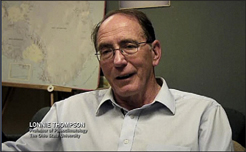
(Bob Sacha, Asia Center on U.S.-China Relations & MediaStorm)
Sacha says it can be pointless to use even the best experts if their language is too complicated and jargon-laden for his audience. “At some point, the expert must put the points in everyday terms,” Sacha says. As an example, in a story for the Asia Society on global climate change, Sacha used the voice of an expert, Lonnie Thompson, a professor of paleoclimatology at Ohio State University. In this story, the expert made the analogy between glaciers melting and a dwindling bank account.
“You can think of a glacier as a bank account—as a water bank account,” Thompson says in the story, “that has been built up over thousands of years. In the beginning of the 21st century we are taking more out of that bank account than is being put in. Of course we all know that long-term with any bank account if you do that, it will soon be empty”.
“That analogy was a stroke of luck because everybody can understand a shrinking bank account,” said Sacha.
Global warming may seem like a complex scientific topic to explain in a video story intended for a general public, but if your expert can relate to the audience in a way that makes the subject appealing to everyone, then you’re in business.
Finally, if you can strike a comfortable balance between experts’ knowledge and the experience of people at ground level affected by the phenomenon, then you have a story that your audience can both comprehend and be emotionally moved by. Your goal is to teach your audience and at the same time touch a nerve with them.
HOW TO BEGIN THE STORY
How cleverly you tell the story will determine your story’s arc. Though it may seem that this arc really develops after the field reporting is done—and it very well may—you want to be concerned with your narrative plan before you get started and keep it in mind throughout the reporting process.
The Audience Is Watching … the Clock
Here’s the good news.
According to a survey of Internet video viewers, if your video story is less than 10 seconds long, about 89 percent of viewers will watch your whole video.
The bad news?
There just aren’t that many 10-second videos out there. Most journalistic video stories are much longer. If your story is about 30 seconds long, the study shows that about two-thirds of your viewers will finish watching it. Make it 30 seconds longer and fewer than half the viewers will stay till the end. Because most online video stories are in the 1:30 to 3:00 range, you may only hope that 10 to 20 percent of viewers will watch all of yours. The aim of the game in videojournalism is to create gripping, well-wrought stories that grab a viewer’s eyeballs and do not let go until the every last frame.
▲ Audience Attention Span. The average drop-off rate in audience attention span presents a constant challenge for videojournalists. ![]()

Source: Tubemogul, a video analytics platform for research.
As video and multimedia storytellers, we are fighting an uphill battle. The wide general audience we keep talking about—your average viewer—is probably checking email, chatting online with a friend, and visiting another two or three websites while your story is loading and playing. Once you have grasped this discouraging fact, you can start to see just how compelling and engaging your stories must be in order to compete with the daily avalanche of online distractions all your potential viewers deal with.
The first 10 to 20 seconds of your story is without a doubt the most important part. Keeping a viewer’s eyeballs glued to the screen while your show is playing is, of course, the ultimate challenge. It takes research and planning and a knack for telling a story. But if you have gotten this far and are still interested in trying to create multimedia stories, you are probably a fine candidate for this fascinating profession.
Combine a Powerful Quote and Shocking Action
Study the first 10 to 20 seconds of strong films. Have a look at the 1983 documentary film Streetwise, by Martin Bell. In a few short minutes, Bell’s audience is focused on the story and its characters. The film begins with a powerful quote. One of the street kids, by the name of Rat, is standing on a bridge. It appears he is getting ready to jump off. “I love to fly,” says Rat. “It’s just you alone. You have peace and quiet, nothing around you but clear blue sky. No one to hassle you. No one to tell you where to go or what to do.” Then he adds, “The only bad part about flying is having to come back down to the fucking world”.
As soon as Rat jumps off the bridge into the river, the film cuts to scenes of Seattle in the early 1980s. First a wide view with ships, trains, long views, then it narrows quickly onto the street. We hear street performances and boom box music and then meet the main characters of the film. Another kid is panhandling and says to a passerby, “Spare some change, ma’am, so me and my father can get something to eat?”
This intro of less than two minutes in a feature-length documentary film sets the mood and hooks the audience with a powerful quote and a kid’s terrifying leap from a bridge, and then a panoramic shot of the setting that quickly establishes a sense of place.
◀ Streetwise. To grab viewers’ attention, the producer opened his documentary on street kids in Seattle with a teenager jumping from a bridge with shocking dialog. ![]()

(Producer, Martin Bell. Courtesy of Angelika Films)
Be bold! Think about this. Is there a powerful line from the peak or climax of your story that might be a great way to start? Sometimes it’s seductive to hint or foreshadow where your audience will be taken. PBS’s Frontline tells a story of assisted suicide that follows the saga of an American afflicted with the disease ALS as he decides to end his own life. In the opening scene, he is on a plane taking off for Switzerland, where he will eventually end his suffering. The very beginning is dramatic because he is declaring right at the start of the story that he is going on a trip to end his life. For the moment, the audience can only imagine or wonder why. But that initial statement is a shot square in the solar plexus. Dramatic beginnings that leave unanswered questions are terrific ways to start a story.
▲ The Suicide Tourist. To seize the viewer, the producer opens this documentary with Craig Ewert saying he is taking a trip to commit suicide. ![]()
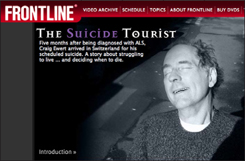
(Produced by John Zaritsky, Frontline)
Don’t be afraid to use quotes and symbols. But don’t fall into the trap of trying to be too clever with symbolic imagery or obscure quotes that force the viewer to work in order to understand what is going on. Very early on, you need to tell the viewer what the story is about. But you don’t want to confuse or alienate an audience with show-off grandiosities.
Hook Them with Humor
Don’t shy away from humor. If you can get viewers to laugh up front, they’ll assume they may be in for more fun later.
Photographer Katie Falkenburg produced a short story about love and work. She begins with humor to engage her audience. This is a story about Richard and Debbie, a middle-aged couple in love, and how they helped one another find and start a business.
▲ Labor of Love. The producer selected a funny line of dialog to start a story about how a couple began their mobile pet grooming business. ![]()
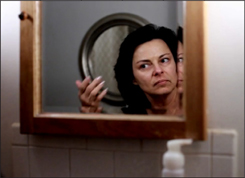
(Produced by Katie Falkenberg)
The story begins with a description of how they met and what attracted the two to one another. It opens with Richard singing, “She’s my girlfriend, she’s my girlfriend, and I love her to the very end”.
Debbie’s voice comes in speaking, “If I could have George Clooney or Richard, I would pick Richard. I really would.” Then Debbie adds with a hint of laughter, “I might have George Clooney’s photo, but yeah, [Richard’s] definitely a keeper”.
By using this touching bit of humor, the story seduces the audience with the whimsical side of the characters and lends a tone of light-heartedness that carries us along throughout the piece. If your characters are funny, let them be funny. Their humor can only enhance your story.
Throw the Viewer into the Story
You want to plunk people right into the action. For instance, get a main character to recount and retell a part of the story so your viewers feels as though they, too, are reliving it right in front of their eyes. In a piece in the Raleigh News & Observer, photographer Shawn Rocco and Travis Long report on a wrongfully convicted and imprisoned man who is exonerated and released. The photographer uses this “character retelling the story” technique. In this example, the character is really reliving the story right in front of the viewers. It’s quite a compelling method of drawing in viewers.
▲ Dail: Life Unbarred. Accused of rape, Dwayne Dail lost half his life to prison before DNA evidence found on the victim’s nightgown proved his innocence. In the video, Dail tells his own story. ![]()
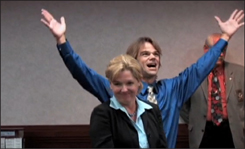
(Footage: Shawn Rocco, Travis Long, interviews: Mandy Locke, stills: Shawn Rocco, editing: Travis Long, Shawn Rocco)
What the Hell Was That?
Put something out there in audio or visuals (or both) that makes the audience say, “What the hell was that?” Build it slowly and little by little make them wonder. Give only a little smidgen away at a time. If you spill all the beans up front, there is no reason for a viewer to stay with you. Hook them with the bizarre, but keep it relevant. The perfect story won’t all happen at once. These techniques take practice, and practice, we already know, makes perfect. Trying different approaches will eventually lead you to the one that works for you.
In a video story by PRI’s This American Life, which tells the story of a group of young people in North Philadelphia who ride horses, viewers are presented first with a look at the inner city, and then we see horseback riders pass through each frame. There is only music covering these shots, so it sets viewers to wonder, “What the hell was that?” It’s an excellent trick when you can pull it off because their very wonderment will make them want to continue. Basically, you want to try to do something that puzzles your viewers and urges them stay with you.
Delayed Lead
Bob Sacha worked with Reuters photographer Lucy Nicholson and visual projects editor Jassim Ahmad during a MediaStorm workshop. The pair wanted to do a story about Times Square in New York City. After discussing five possible story ideas, the two journalists settled on the Naked Cowboy, an icon of Times Square. But Sacha had concerns about the story. Several Naked Cowboy stories had been done, he said; plus, the Naked Cowboy is a celebrity, and celebrities rarely open up the way he likes his subjects to do. Visually, of course, “it would be like shooting fish in a barrel,” Sacha said, “but we had no story”.
As the three were leaving the first interview with the Naked Cowboy at home, the subject’s girlfriend arrived. Nicholson asked her, “What’s it like to be the Naked Cowboy’s girlfriend?” Sacha says, “She totally opened up, told us all about how they met on the elliptical machines at the gym. It was a boy-meets-girl story,” Sacha says. “The lightbulb went on!”
The relationship, of course, ensured the universality of this story. But what set it apart was that the relationship was that of someone public, someone famous. Everybody wants to know what is it like being the Naked Cowboy’s girlfriend. Says Sacha, “Imagine what’s it like to be in a relationship with a guy in such dazzling shape with a dazzling ego to match. What makes this naked cowboy so irresistible in Times Square is precisely what makes him so problematical for her.” So the Naked Cowboy story is not just about a celebrity, per se. It’s about a singular relationship, and a complex one at that!
▲ One Man Band: The Naked Cowboy. The Naked Cowboy playing in Times Square was a celebrity, but alone he did not make a story.
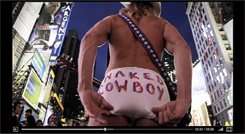
▼ When the photographer discovered that the Naked Cowboy had a girlfriend, they realized they could give the story a new X twist by telling it from two points of view. ![]()

(Photos by Lucy Nicholson Reuters)
Once they determined what their story would be about, Sacha and his team quickly made a plan for the opening of the story. “We knew we wanted to hide the fact from the viewer that the subject was the famous Times Square Naked Cowboy. We knew that to start the story we wanted a video of the couple working out together on the elliptical machines at the gym. So our story begins by hearing the story of a regular girl meeting a regular guy at the gym. They chat. She asks him where he plays his guitar. He gives the address. He even hints that everyone knows him. But still, as the story inches forward, we still are not aware of who he really is. Then, BAM! All of a sudden Jack is out of the box and our hero becomes the Naked Cowboy! That’s when the two personalities really come alive.
THE END WILL BE REMEMBERED
Viewers tend to remember the beginnings and endings of stories. Make the end as good as the beginning. Be cognizant of how you want to leave your audience. Remember, they have invested precious minutes watching your piece. Don’t just end the story without offering some satisfying closure.
If your finale is weak, no one will remember the story. The obvious fallout from a flabby ending is that people probably won’t come back for any other stories.
Three Essentials to End the Story
In an essay for the Nieman Foundation for Journalism at Harvard, Bruce DeSilva, an author and former writing coach for the Associated Press, observes, “A good ending absolutely, positively, must do, at a minimum, three things: One, it must tell the reader the story is over. It must do that. Two, it also needs to nail the central point of the story to the reader’s mind. You (the writer) have to leave the reader with the thought you mean him to be taking away from your story. And three, that thought should resonate; it really should. You should hear it echoing in your head when you put the paper down, when you turn the page. It shouldn’t just end and have a central point. It should stay with you and make you think a little bit”.
▲ Intended Consequences. The story of Rwandan women who had been raped by men of a different tribe ends with a montage of images of the mothers and of their children. The video closes on a hopeful note with the last child going from a serious face to a smile. ![]()

(Story by Jonathan Torgovnik; produced by Chad Stevens, MediaStorm)
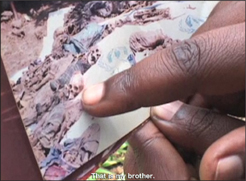
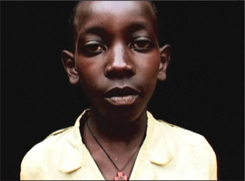
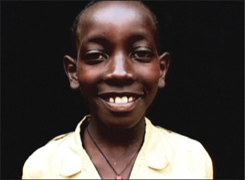
Although DeSilva is talking about the written story, the same can be said for a video story. In “Intended Consequences” by Jonathan Torgovnik, near the beginning of the story, there is a portrait montage of some African mothers. According to Chad Stevens, the story’s producer for MediaStorm, you can see the scars of experiences of these Rwandan women who were raped and then gave birth to children of the Hutu militiamen. The central point of the story asks the question: can these women and these children overcome these scars? This point is reinforced at the end of the story. “The children’s fates are unknown,” says Stevens. “Will they get any education? Can they overcome the drastic ethnic boundaries? Will they make it to adulthood? Questions remain unresolved. Or maybe because their futures are unknown, there is still room for hope. The story ends with a montage of the children’s portraits, echoing the mothers’ portraits from the opening. The children’s expressions are quite different. Their scars aren’t as deep. A smile signals hope.” Stevens says this story required the infusion of a sense of hope so that the viewer could envision change and maybe even be motivated to act. This story, like all good stories, resonates. It stays with the viewer after the last image fades from the screen.
▼ Motel Manor Suburban Homelessness. The intersection of Interstate 70 and Highway 40, dubbed the “crossroads of the nation,” is also where suburbia meets a national problem. Two motels here have become home to St. Charles County’s chronically struggling, homeless, fragile families.
Two-year-old Drew Trantham plays in puddles in the parking lot, his playground, outside the Budget Inn in Wentzville. His parents, Cherri and Joe Trantham, and sister Mary, age 1, moved into the hotel after losing their trailer to foreclosure. ![]()
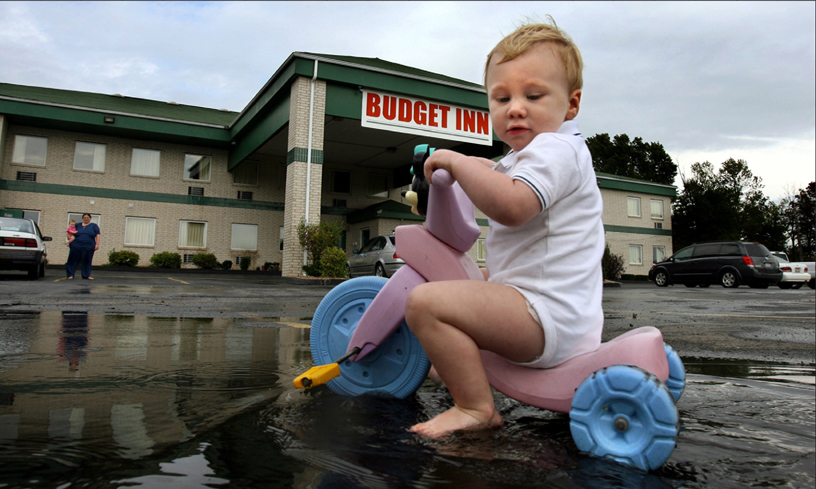
(Photo by Robert Cohen, Louis Post-Dispatch)
End the Story with a Punchline
Robert Cohen, a photographer at the St. Louis Post-Dispatch, shot and produced a story on the U.S. economy that focused on homeless families living in hotels in a middle-class suburb of St. Louis, Missouri. His story followed families in a paradoxical setting. Many people believed there were no homeless families living there. Using both familiarity and access, Cohen tells their personal stories as a way to put faces on the economic crisis. The story concludes as one father has found work at a local McDonald’s restaurant. Though the job certainly isn’t the solution to releasing his family from a tentative life in a hotel to one in their own home, at least it produces a sense of hope.
▲ Joe and Cherri Trantham moved their family of four to the Budget Inn after losing their home. Joe works at a nearby McDonald’s. He brings home dinner at the end of his shift.
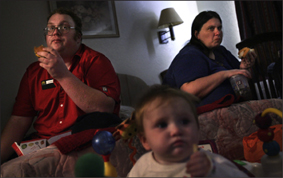
◀ The Budget Inn and Economy Inn are, for many, a place to grab a cheap, no-frills $36 room on a road trip. For others with no place to turn, it’s the last-chance inn.

◀ “I’m glad to be back … to be able to provide for my family,” says Joe Trantham about his new job at McDonald’s. Here, he gets ready to go to work with his daughter Mary at his side.
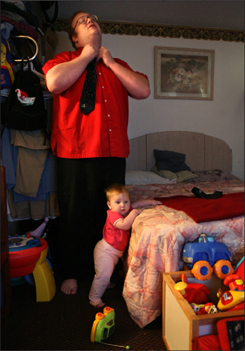
▼ When the family checked into the motel, they registered with no home address.

▲ A school bus transports homeless children between the motels and their schools in Wentzville.

◀ “When you go on vacation and stay in a motel … you’re able to spend time with your family and not worry about nothing,” says Cherri Trantham. “But when you live in a motel, you’re like when is this vacation gonna end so you can get to go to your own home”.

The final comment in the piece comes from his wife, who explains that for many families, going to a hotel is a vacation, where people clean up after you. Cherri just wants their vacation to end so they can leave the motel and move into their own home. This poignant ending serves two purposes: first, it connects the audience to a universal and familiar experience—staying in a hotel. But it just as poignantly reminds viewers that for this family, the hotel experience is turned on its head. Second, it says to the audience, “This story isn’t over. It continues. And nobody knows how it will end. There is some hope, but there are no promises”.
Story endings are critical. In this case, the use of Cherri’s poignant quote aptly sums up the feeling, the experience and the moral of the story. It is an excellent way to provide the audience with a sense of closure.
